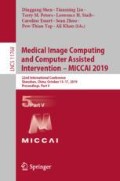Abstract
Datasets for training gastric cancer detection models are usually imbalanced, because the number of available images showing lesions is limited. This imbalance can be a serious obstacle to realizing a high-performance automatic gastric cancer detection system. In this paper, we propose a method that lessens this dataset bias by generating new images using a generative model. The generative model synthesizes an image from two images in a dataset. The synthesis network can produce realistic images, even if the dataset of lesion images is small. In our experiment, we trained gastric cancer detection models using the synthesized images. The results show that the performance of the system was improved.
Access this chapter
Tax calculation will be finalised at checkout
Purchases are for personal use only
References
Baur, C., Albarqouni, S., Navab, N.: MelanoGANs: high resolution skin lesion synthesis with GANs. arXiv:1804.04338 (2018)
Beers, A., et al.: High-resolution medical image synthesis using progressively grown generative adversarial networks. arXiv:1805.03144 (2018)
Frid-Adar, M., Diamant, I., Klang, E., Amitai, M., Goldberger, J., Greenspan, H.: GAN-based synthetic medical image augmentation for increased CNN performance in liver lesion classification. Neurocomputing (2018). http://www.sciencedirect.com/science/article/pii/S0925231218310749
Goodfellow, I., et al.: Generative adversarial nets. In: NIPS (2014). http://papers.nips.cc/paper/5423-generative-adversarial-nets.pdf
Hayakawa, A., et al.: Gastric cancer detection for gastroenterological endoscopy with local and multi-scale global information. In: CARS (2019)
Hirasawa, T., et al.: Application of artificial intelligence using a convolutional neural network for detecting gastric cancer in endoscopic images. Gastric Cancer 21, 653–660 (2018)
Iizuka, S., Simo-Serra, E., Ishikawa, H.: Globally and locally consistent image completion. ACM Trans. Graph. 36, 107 (2017)
Kawahara, J., Hamarneh, G.: Multi-resolution-tract CNN with hybrid pretrained and skin-lesion trained layers. In: MICCAI (2016)
Liu, W., et al.: SSD: single shot MultiBox detector. In: Leibe, B., Matas, J., Sebe, N., Welling, M. (eds.) ECCV 2016. LNCS, vol. 9905, pp. 21–37. Springer, Cham (2016). https://doi.org/10.1007/978-3-319-46448-0_2
Lo, Y.C., et al.: Glomerulus detection on light microscopic images of renal pathology with the faster R-CNN. In: Cheng, L., Leung, A.C.S., Ozawa, S. (eds.) Neural Information Processing (2018)
Radford, A., Metz, L., Chintala, S.: Unsupervised representation learning with deep convolutional generative adversarial networks. In: ICLR (2016)
Redmon, J., Farhadi, A.: YOLOv3: an incremental improvement. arXiv:1804.02767 (2018)
Ren, S., He, K., Girshick, R., Sun, J.: Faster R-CNN: towards real-time object detection with region proposal networks. In: NIPS (2015)
Shen, W., Zhou, M., Yang, F., Yang, C., Tian, J.: Multi-scale convolutional neural networks for lung nodule classification. In: IPMI (2015)
Xian, W., et al.: TextureGAN: controlling deep image synthesis with texture patches. In: CVPR (2018)
Xiao, T., Zhang, C., Zha, H.: Learning to detect anomalies in surveillance video. IEEE Signal Process. Lett. 22, 1477–1481 (2015)
Xiao T., Zhang C., Z.H.W.F.: Factorization and spatio-temporal pyramid. In: ACCV (2014)
Yi, X., Walia, E., Babyn, P.: Generative adversarial network in medical imaging: a review. Med. Syst. (2018)
Zhang, Z., Xie, Y., Yang, L.: Photographic text-to-image synthesis with a hierarchically-nested adversarial network. In: CVPR (2018)
Acknowledgements
This work was supported by a Grant for ICT infrastructure establishment and implementation of artificial intelligence for clinical and medical research from the Japan Agency of Medical Research and Development AMED (JP18lk1010028).
Author information
Authors and Affiliations
Corresponding author
Editor information
Editors and Affiliations
1 Electronic supplementary material
Below is the link to the electronic supplementary material.
Rights and permissions
Copyright information
© 2019 Springer Nature Switzerland AG
About this paper
Cite this paper
Kanayama, T. et al. (2019). Gastric Cancer Detection from Endoscopic Images Using Synthesis by GAN. In: Shen, D., et al. Medical Image Computing and Computer Assisted Intervention – MICCAI 2019. MICCAI 2019. Lecture Notes in Computer Science(), vol 11768. Springer, Cham. https://doi.org/10.1007/978-3-030-32254-0_59
Download citation
DOI: https://doi.org/10.1007/978-3-030-32254-0_59
Published:
Publisher Name: Springer, Cham
Print ISBN: 978-3-030-32253-3
Online ISBN: 978-3-030-32254-0
eBook Packages: Computer ScienceComputer Science (R0)


